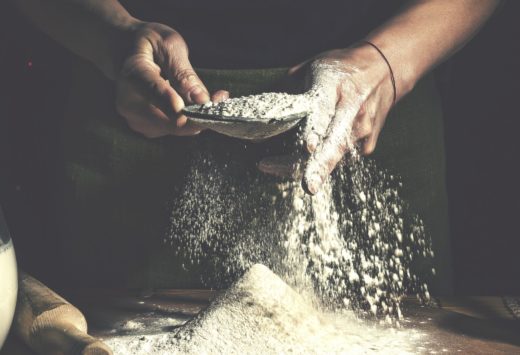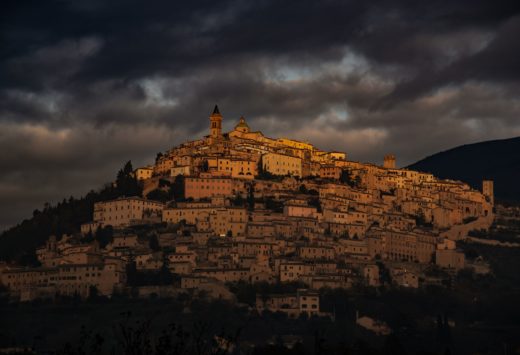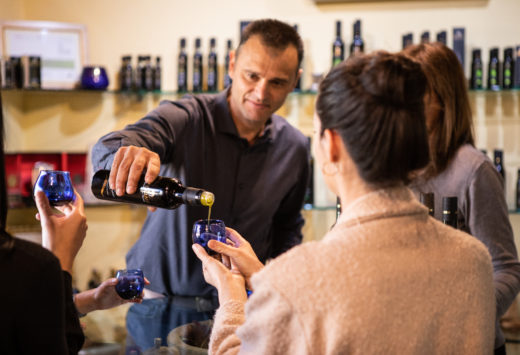Umbria is a region suspended in time, with ancient traditions wisely safeguarded and handed down through the centuries from generation to generation. To grasp its essence, you only need to taste one of the products that best embodies its long and patient farming tradition: extra virgin olive oil.
The region’s ‘green gold’ has been produced in Umbria for more than two thousand years. It was probably introduced into the area by the Phoenicians from Magna Graecia, and around the 6th century BC the olive tree spread to a large part of peninsular Italy. It was initially the Etruscans, followed, above all, by the Romans who spurred the development of this type of cultivation and in fact, in the imperial period, cultivation of olive groves was very similar in extension to the present day.
The Romans put olive oil to all sorts of uses: lighting, religious rites, cosmetics, to protect soldiers’ bodies during battle and, of course, for food purposes. They were so skilled in the art of oil production that they adopted various names to identify the quality of the product, including: oleum ex albis ulivis for the highest-quality oil obtained by pressing green olives, oleum maturum from pressing already black, ripe olives, oleum caducum from olives harvested from the ground and therefore of lesser quality, and oleum cibarium for poor quality oil extracted from olives infected by pests and intended for feeding slaves or for other uses.
During the Dark Ages that followed the fall of the Roman Empire (476 AD), olive groves were gradually abandoned until the 11th century. Around the year 1000, in fact, the green hills of Umbria and Tuscany started to become dappled with the silver hue of olive trees almost as densely as in the past. Credit is due mostly to monastic communities which, thanks to the reclamation of marshy lands, contributed to the planting of new olive groves and vineyards, giving new impetus to agriculture. The landscape around abbeys, cities and castles took on the picturesque appearance it still has today, filled with well-aligned rows, almost perfectly square fields, and with the typical silvery colour of olive-tree foliage. It is probably around this time that Umbria’s great olive oil tradition was born, and it arguably boasts one of the finest productions of extra virgin olive oil in Italy in terms of its organoleptic characteristics, as attested by the numerous awards made to many Umbrian companies in the sector.
In 1998, Umbria was the first Italian region to be awarded the quality label known as DOP (Protected Designation of Origin or PDO) by the European Union for the extra virgin olive oil produced throughout the territory. Specifically, the Umbria DOP is divided into five sub-areas or geographical indications, which differ from each other in terms of microclimate and variety of cultivars (olive varieties):
- Colli Assisi Spoleto, the most extensive, occupies the entire eastern part of the region right down to the south, producing oil with an intensely herbaceous aroma and marked bitter and spicy notes;
- Colli Martani occupies the central part of the region and produces fruity oil, with mid-range herbaceous nose and satisfying bitter and spicy nuances;
- Colli Amerini, the smallest area, is in the southern part of the region and produces oil with a medium-light fruity aroma with hints of artichoke adding a pleasant bitterness to the flavour;
- Colli del Trasimeno refers to the areas near Lake Trasimeno, in the north-western part of the region, and produces oil that is appreciated for its light fruity aroma of freshly-cut grass, while the flavour has a balanced combination of mildly bitter and spicy hints;
- Colli Orvietani, in the central-western part of the region, produces oil with a mid-level herbaceous-fruity nose merging with harmonious bitter and spicy notes on the palate.
But to really get a feel for these ancient traditions, you have to visit Trevi. This lovely medieval village nestled among the olive trees on the ancient Roman Via Flaminia, halfway between Spoleto and Foligno, is famous throughout Italy for its age-old olive oil-producing tradition. A visit to the Museo della civiltà dell’Ulivo is a must. Located inside the former convent of San Francesco, this lovely 13th-century building was restored in the 19th century by Giuseppe Valadier. Another unmissable sight near Trevi – or more precisely in Bovara, near the Benedictine abbey – is the ‘Sant’Emiliano olive tree’, considered the oldest olive tree in Umbria: listed as protected, it is named after Emiliano, bishop of Trevi, because he was tied to it and beheaded over a thousand years ago. Trevi is also a stop on the Sentiero degli Ulivi, a fabulous nature trail amongst the olive groves in the hills that connect Assisi to Spoleto. Along the way, you’ll come across the ‘olive houses’ dating back to the 16th century and used for lodging purposes during the harvest period.






